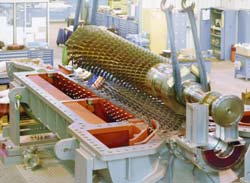Air Compressor of Unrivaled Power for Plastics

Each one can compress 700,000 cubic meters of air to 2.4 bar every hour, which is the highest flow rate of an axial-flow compressor in the world. The plant will start up in 2013 and produce propylene as the source material for the plastic polypropylene.
In a first, the compressor train for this plant will be implemented as an axial-flow compressor driven by gas turbines. The plant is the first propane dehydrogenation project (PDH) in China and has a capacity of 600,000 metric tons propylene per year. It will be operated by the Chinese Tianjin Chemical Industry Group Co., a chemicals company specializing in plastics processing.
There is a growing demand for plastics and thus for propylene in China, as in all of Asia. With the construction of PDH plants, China is meeting this demand and at the same time developing an industry for processing natural gas. Up to now, propylene has been obtained mostly along with ethylene as a result of petroleum cracking in refineries. But since the demand for propylene is increasing faster than that for ethylene, dedicated production of propylene is becoming increasingly important.
The process with the highest selectivity for propylene (over 85 percent) is based on the Catofin technology of U.S. company CB&I Lummus. In this technique, propylene is manufactured in a catalytic process by dehydrogenating propane — i.e. removing some of its hydrogen. The propane gas usually comes from natural gas.
In the Catofin process, the catalyst must be repeatedly heated up and regenerated with compressed, heated air in alternation with the dehydrogenation reaction. In the new plant, this air is supplied by two Siemens compressor trains. Until now, axial-flow compressors of this sort have only been used in blast furnaces or refinery processes. In the project in Bohai, China, they are now being used for the first time in a propane dehydrogenation plant in the petrol industry.
Another novelty is the combination of an axial-flow compressor with a gas turbine. Gas turbines are a suitable drive system at the Chinese plant, because they can be run on both propane gas from the plant and natural gas from a pipeline. Gas turbines and axial-flow compressors both have high efficiency rates. The combination of the two systems is therefore also very efficient.
Media Contact
More Information:
http://www.siemens.com/innovationnewsAll latest news from the category: Machine Engineering
Machine engineering is one of Germany’s key industries. The importance of this segment has led to the creation of new university degree programs in fields such as production and logistics, process engineering, vehicle/automotive engineering, production engineering and aerospace engineering among others.
innovations-report offers informative reports and articles covering technologies such as automation, motion, power train, energy, conveyor, plastics, lightweight construction, logistics/warehousing, measurement systems, machine tools and control engineering.
Newest articles

Largest magnetic anisotropy of a molecule measured at BESSY II
At the Berlin synchrotron radiation source BESSY II, the largest magnetic anisotropy of a single molecule ever measured experimentally has been determined. The larger this anisotropy is, the better a…

Breaking boundaries: Researchers isolate quantum coherence in classical light systems
LSU quantum researchers uncover hidden quantum behaviors within classical light, which could make quantum technologies robust. Understanding the boundary between classical and quantum physics has long been a central question…

MRI-first strategy for prostate cancer detection proves to be safe
Active monitoring is a sufficiently safe option when prostate MRI findings are negative. There are several strategies for the early detection of prostate cancer. The first step is often a…



